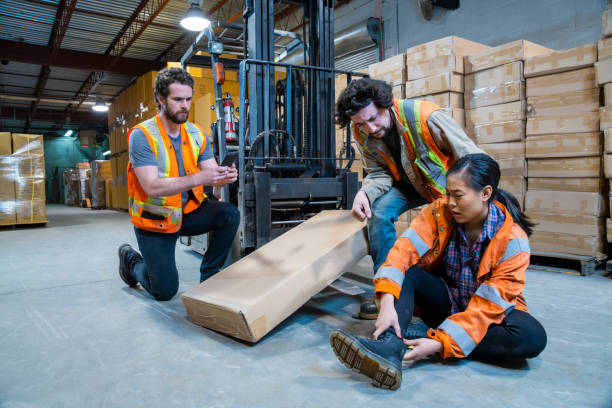Accidents and Compensation for Warehouse Workers
Uncategorized November 23, 2021, Comments OffIt is estimated that over 1.1 million people work in warehouses in the United States, but the industry is developing at a quick rate and more and more individuals are taking warehouse jobs every year, according to the Bureau of Labor Statistics.
As a warehouse worker, your life is in jeopardy. Overexertion injuries, stumbles, slips, and falls, loading dock injuries, forklift accidents, and more are just some of the hazards that workers confront on the job. Keeping workers safe from avoidable injuries and accidents is a top priority for businesses because of the inherent dangers of the work they do.
Workers at companies like Amazon, UPS, FedEx, and Walmart number in the tens of millions. More than $50 million has been invested in the construction of new industrial complexes along the I-78 corridor, the PA Turnpike, and other key highways in Pennsylvania.

A Warehouse’s Risks
Among the many duties of a warehouse worker are the packaging and management of orders, the shipment of goods, the retrieval of goods, and the organization of inventories. Some warehouse workers may also be exposed to heavy industrial machinery, such as forklifts and labeling machines. By OSHA’s estimation, warehouse employees are most at risk from these three dangers:
The design is ill-fitting. MSDS, or musculoskeletal disorders, can be caused by repetitive actions, inappropriate lifting, and substandard operation design. Long-term or permanent disability can be caused by musculoskeletal diseases
Improper practices for locking and tagging industrial machinery. Lockout/tagout devices prevent machinery from unexpectedly starting up and releasing dangerous energy, which can result in disastrous repercussions for workers and the general public.
Belts for conveying. Pinch points and in-going nip points can cause severe injuries, such as amputations if a body component gets caught. Workers are also at risk of being struck by falling debris.
Accidents involving forklifts. Forklift accidents result in more than 100,000 injuries and 100 deaths each year. Most of these deaths are caused by forklift rollovers or turnovers.
Accidents involving docks and dock plates. Warehouse injuries can be avoided if dock plates and dock edges are not properly secured or marked.
Material that has been improperly stored.
Chemical Burns as a Result of a Spilled Hazardous Substance
Workers at warehouses are exposed to a variety of hazards on a daily basis, as you can see. Additionally, companies are legally obligated to provide appropriate remedies to mitigate recognized hazards. For this reason, OSHA has put in place a number of safety and health rules for warehouse companies to follow.
A Work-Related Injury?
A large number of warehouse accidents, both deadly and non-fatal, are avoidable. It is unfortunate that the fatal injury rate for workers in the warehouse industry is still higher than in other industries, highlighting the importance of greater workplace safety. When it comes to safety, warehouse companies are most frequently cited when it comes to forklifts, floor openings and holes (such as those found in walls), respiratory protection, lockout/tagout procedures, fire protection programs, and electrical system designs and wiring.
Employers are ultimately responsible for ensuring the safety of their employees’ workplaces. Compliance with federal safety requirements, safety training in a language workers can understand, complete reports of work-related illnesses and injuries, hazard communication programs, and regular job site inspections are only some of the important obligations of employers to achieve this.
It is possible that a third party is to blame for an individual’s injuries in specific situations. Despite the fact that all makers of industrial equipment have a responsibility to produce safe goods, they may choose to prioritize financial gain over safety. In the event that a machine causes harm to a worker as a result of a design error, a lack of safety features, or inadequate guarding, a product liability claim should be considered, but only with the help of workers compensation attorneys. When an outside machine maintenance provider fails to properly examine and maintain job site equipment, it puts personnel at risk.
